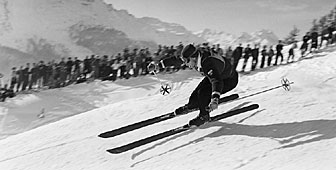King of the hill

The 72nd edition of Switzerland's legendary Lauberhorn ski race takes place on Saturday, watched by one former champion who's attended every single competition.
Born and raised in the village of Wengen, close to the finish line of the classic four-and-a-half kilometre race, 81-year-old Karl Molitor has been associated with the Lauberhorn for almost his entire life.
Local legend
Still highly active, Molitor runs a sports shop in the centre of Wengen but few of the holiday-makers hiring his skis ever realise that they are doing business with a figure of local legend.
Winner of the gruelling Lauberhorn downhill race on a record six occasions between 1939 and 1947, Molitor also celebrated five victories in the slalom discipline. But his links with the country’s most prestigious skiing event began in 1930 when, as a young boy, he witnessed the race’s humble birth.
“It all began when a number of English officers stationed in India came here for some winter relaxation,” Molitor explained to swissinfo from the warmth of his shop. “They were very good skiers and were always comparing their athleticism against that of the local people.
“In 1930, Ernst Gertsch decided to organise the first competition to see who really were the better skiers.”
Major event
Since those days of friendly rivalry, the Lauberhorn race has grown into a major event on the professional sporting calendar with Molitor being followed onto the winner’s podium by some of the biggest names in world skiing.
Austria’s Toni Sailer, Karl Schranz and Franz Klammer have all celebrated famous victories on the Lauberhorn as have the Frenchmen Jean-Claude Killy and Henri Duvillard while Switzerland’s Bernhard Russi, Roland Collombin, Toni Bürgler, Peter Müller, Franz Heinzer and William Besse have provided the biggest cheers for the local supporters.
“Skiing as God intended”
Much has of course changed since the early days of Molitor and his beloved race. “In my day we skied the Lauberhorn as God intended it,” Molitor is particularly keen to point out. “Today they use snow cannon and piste bashers to manufacture the piste.”
But the route of the World Cup’s longest ski race has remained generally faithful to Molitor’s memory as it snakes its way from the foot of the Jungfrau mountain to the edge of the Wengen village. Still a regular traveller down its long and winding course, Molitor recites the points of interest like a list of former lovers.
“The jump at Russi, the Hundschopf drop, the passage at the Brückli bridge, racing along the straight at the Hanneggschuss before plunging into the finish area with your legs on fire.”
The face of Karl Molitor lights up as he describes the race course that has been so inextricably linked with the course of his own life. In the Lauberhorn, Molitor sees a vitality and splendour similar to that of the Eiger, Mönch and Jungfrau peaks which overlook his village.
“The mountain tops are always beautiful,” he explains, “and different every time.” Just like the Lauberhorn, it seems, and who can argue with a man who has actually seen the race in each of its previous incarnations?
by Mathias Froidevaux and Mark Ledsom, Wengen

In compliance with the JTI standards
More: SWI swissinfo.ch certified by the Journalism Trust Initiative








You can find an overview of ongoing debates with our journalists here . Please join us!
If you want to start a conversation about a topic raised in this article or want to report factual errors, email us at english@swissinfo.ch.